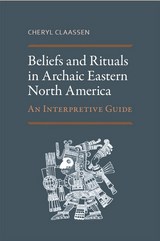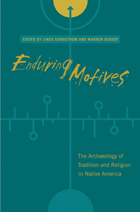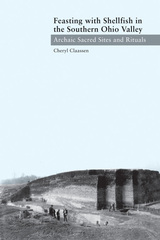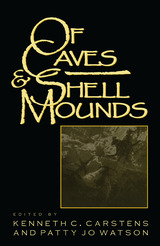
Beliefs and Rituals in Archaic Eastern North America describes, illustrates, and offers nondogmatic interpretations of rituals and beliefs in Archaic America. In compiling a wealth of detailed entries, author Cheryl Claassen has created both an exhaustive reference as well as an opening into new archaeological taxonomies, connections, and understandings of Native American culture.
The material is presented in an introductory essay about Archaic rituals followed by two sections of entries that incorporate reports and articles discussing archaeological sites; studies of relevant practices of ritual and belief; data related to geologic features, artifact attributes, and burial settings; ethnographies; and pilgrimages to specific sites. Claassen’s work focuses on the American Archaic period (marked by the end of the Ice Age approximately 11,000 years ago) and a geographic area bounded by the edge of the Great Plains, Newfoundland, and southern Florida. This period and region share specific beliefs and practices such as human sacrifice, dirt mound burial, and oyster shell middens.
This interpretive guide serves as a platform for new interpretations and theories on this period. For example, Claassen connects rituals to topographic features and posits the Pleistocene-Holocene transition as a major stimulus to Archaic beliefs. She also expands the interpretation of existing data previously understood in economic or environmental terms to include how this same data may also reveal spiritual and symbolic practices. Similarly, Claassen interprets Archaic culture in terms of human agency and social constraint, bringing ritual acts into focus as drivers of social transformation and ethnogenesis.
Richly annotated and cross-referenced for ease of use, Beliefs and Rituals in Archaic Eastern North America will benefit scholars and students of archaeology and Native American culture. Claassen’s overview of the archaeological record should encourage the development of original archaeological and historical connections and patterns. Such an approach, Claassen suggests, may reveal patterns of influence extending from early eastern Americans to the Aztec and Maya.

Wesley Bernardini / James S. Brown Jr. / Cheryl Claassen / John E. Clark / ArleneColman / Warren DeBoer /

In this provocative work, Cheryl Claassen challenges long-standing notions n this provocative work, Cheryl Claassen challenges long-standing notions Iabout hunter-gatherer life in the southern Ohio Valley as it unfolded some Iabout hunter-gatherer life in the southern Ohio Valley as it unfolded some I8,000 to 3,500 years ago. Focusing on freshwater shell mounds scattered 8,000 to 3,500 years ago. Focusing on freshwater shell mounds scattered along the Tennessee, Ohio, Green, and Harpeth rivers, Claassen draws on the latest archaeological research to offer penetrating new insights into the sacred world of Archaic peoples. Some of the most striking ideas are that there were no villages in the southern Ohio Valley during the Archaic period, that all of the trading and killing were for ritual purposes, and that body positioning in graves reflects cause of death primarily.
Mid-twentieth-century assessments of the shell mounds saw them as the products of culturally simple societies that cared little about their dead and were concerned only with food. More recent interpretations, while attributing greater complexity to these peoples, have viewed the sites as mere villages and stressed such factors as population growth and climate change in analyzing the way these societies and their practices evolved. Claassen, however, makes a persuasive case that the sites were actually the settings for sacred rituals of burial and
renewal and that their large shell accumulations are evidence of feasts associated with those ceremonies. She argues that the physical evidence—including the location of the sites, the largely undisturbed nature of the deposits, the high incidence of dog burials, the number of tools per body found at the sites, and the indications of human sacrifice and violent death—not only supports this view but reveals how ritual practices developed over time. The seemingly sudden demise of shellfish consumption, Claassen contends, was not due to overharvesting and environmental change; it ended, rather, because the sacred rituals changed.
Feasting with Shellfish in the Southern Ohio Valley is a work bound to stir controversy and debate among scholars of the Archaic period. Just as surely, it will encourage a new appreciation for the spiritual life of ancient peoples—how they thought about the cosmos and the mysterious forces that surrounded them.

Ancient human groups in the Eastern Woodlands of North America were long viewed as homogeneous and stable hunter-gatherers, changing little until the late prehistoric period when Mesoamerican influences were thought to have stimulated important economic and social developments. The authors in this volume offer new, contrary evidence to dispute this earlier assumption, and their studies demonstrate the vigor and complexity of prehistoric peoples in the North American Midwest and Midsouth. These peoples gathered at favored places along midcontinental streams to harvest mussels and other wild foods and to inter their dead in the shell mounds that had resulted from their riverside activities. They created a highly successful, pre-maize agricultural system beginning more than 4,000 years ago, established far-flung trade networks, and explored and mined the world's longest cave—the Mammoth Cave System in Kentucky.
Contributors include:
Kenneth C. Carstens, Cheryl Ann Munson, Guy Prentice, Kenneth B. Tankersley, Philip J. DiBlasi, Mary C. Kennedy, Jan Marie Hemberger, Gail E. Wagner, Christine K. Hensley, Valerie A. Haskins, Nicholas P. Herrmann, Mary Lucas Powell, Cheryl Claassen, David H. Dye, and Patty Jo Watson
READERS
Browse our collection.
PUBLISHERS
See BiblioVault's publisher services.
STUDENT SERVICES
Files for college accessibility offices.
UChicago Accessibility Resources
home | accessibility | search | about | contact us
BiblioVault ® 2001 - 2024
The University of Chicago Press









